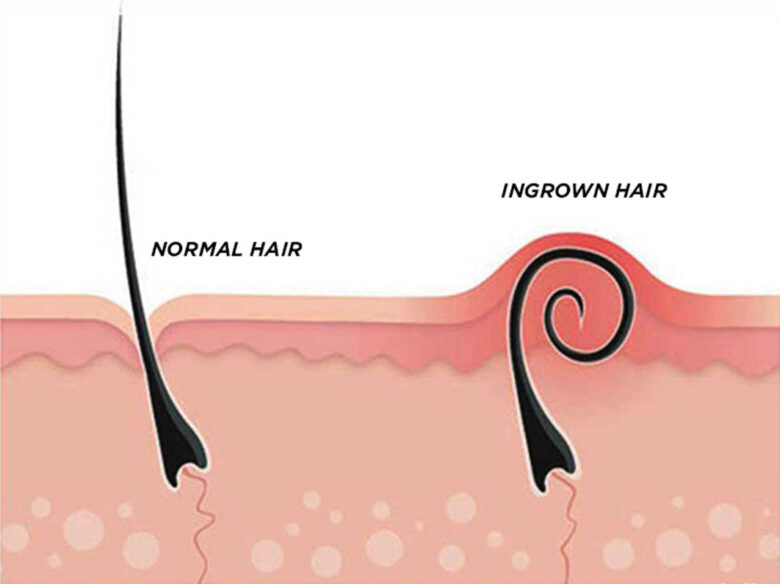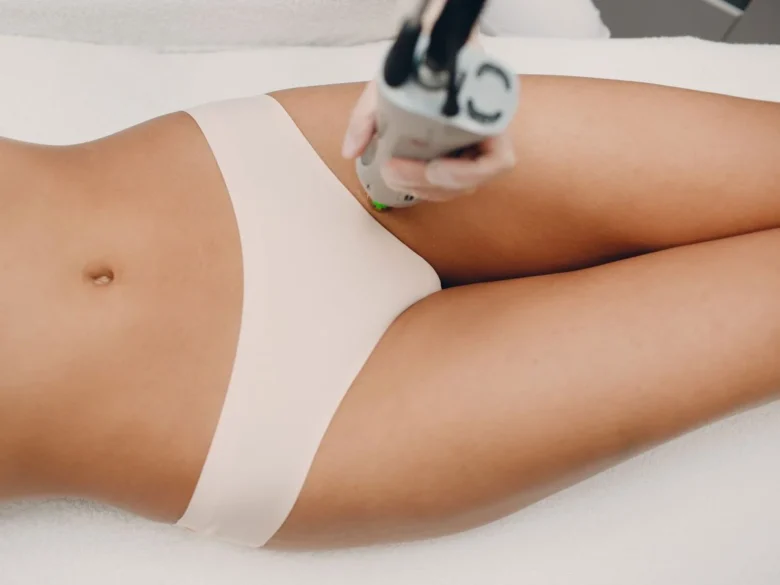Ingrown hair is not just unattractive, it is also very painful . Anyone can develop it; however, its probability greatly increases with waxing, shaving, tweezing, and wearing tight clothes.
While there are tips, tricks, medication, precautions, and more for the treatment of ingrown hairs, it is better to avoid them in the first place. But before we tell you the secret of eliminating ingrown hairs altogether, let’s first find out what it iis, its symptoms, and how it affects us.
Contents
What Is Ingrown Hair?

source:body4real.co.uk
An ingrown hair is hair that grows inside the skin instead of breaking the surface and growing outside. Medically known as “pseudofolliculitis barbae”, it occurs most commonly after shaving, waxing, or tweezing.
When you shave, the cut hair may curl and grow inside the skin. As the it is trapped under the skin, the surrounding area becomes red, itchy, irritated, and inflamed. This is because the body recognizes it as a foreign object and initiates an immune response.
The main reason why a hair follicle is not able to break free and gets trapped is clogging. When the dead skin cells remain on the skin, they can block the pores and form a physical hindrance to the hair. Wearing tight clothes can also cause friction between the hair and the skin, which can cause the hair to turn around and push back into the follicle.
While anyone can develop ingrown hairs, some people are more prone to developing them. This is because the direction of growth and structure play a great role in their development. So people with thick and curly hair are at a higher risk of ingrown hairs.
As the hair in the pubic area is coarse and curly, ingrown hairs are more commonly found in the pubic region.
How Does Ingrown It Affect The Body?
Apart from the pain and discomfort, ingrown hairs are generally unharmful and go away on their own. However, if they don’t, you may have:
- Bacterial and fungal infection (due to scratching of the affected area)
- Razor bumps
- Darkened skin
- permanent scarring
- Raised scars that are darker than the surrounding skin (keloids)
- Fine depressed scars (grooves)
- hair loss
- hair follicle destruction
- Patches of skin that are darker than usual (post-inflammatory hyperpigmentation)
This usually affect the pubic area, armpits, legs, and face (beard area). However, they may also appear on other parts of the body like the chest, scalp, back, inside the nose, eyebrows, abdomen, and buttocks.
Some doctors are of the opinion that ingrown hairs can lead to pilonidal cysts. These cysts are pockets of skin debris and hair. They develop between the buttocks and at the base of the tailbone. They can be very painful and can even swell; and the only treatment is surgical removal.
What are the Causes?

source:verywellhealth.com
In fact, when you remove hair, it tends to grow back. Most shafts easily grow through the skin and do not cause problems. However, others may grow under the skin, especially after shaving, like trimmed hair may curl and begin to grow back into the skin.
Once it grows back into the skin, the body reacts to it as if it were a foreign object. This is where certain symptoms such as pain, itching, redness, and swelling begin. In most cases, this does not require treatment. It often goes away on its own without any treatment. The best way to prevent ingrown hairs is to avoid waxing, shaving, or plucking them. Once an ingrown hair becomes infected, you should visit your doctor to get the proper prescription. In severe infections, antibiotics are required.
What Are The Symptoms?
You may have ingrown hair if you have:
- Small bumps that are filled with pus or look like blisters
- Tiny swollen bumps in the area you shave, wax, or tweeze
- Small bumps darker than the surrounding skin
- Itching
- Stinging or burning
- Loop-shaped hair because the it curves and grows back into the skin
- Long-lasting chronic pain
- Irritation
Ingrown hairs may look red, itchy, and raised spots. Sometimes, the trapped hair is also visible. The small bumps are called papules and the pus-filled ones are called pustules. When the skin around the ingrown hair becomes dark, it is referred to as hyperpigmentation. An ingrown hair may often be confused with a pimple, as both are red bumps that can, sometimes, also have white pus.
How Laser Can Help Get Rid Of Ingrown Hair?

source:besthealthmag.ca
The problem with ingrown hairs is that it is recurring. No matter how many topical applications of steroids, chemical exfoliants, antibiotics, and retinoids you try, you only get temporary relief. They do not fully resolve the problem.
However, one treatment offers a long-term, and, for some, even a lifetime solution to ingrown hairs.
Laser hair removal is the secret to smooth, trouble-free skin. With the laser procedure, you no longer have to worry about ingrown hairs. This is because the laser targets the root of the hair follicle, addressing the issue directly at its source.
The laser destroys the follicle, and once it is destroyed, it will not be able to produce hair. The affected area will heal, and as the follicle is dead, you no longer have to worry about ingrown hairs popping up.
However, the magic does not happen all at once. Complete removal requires a series of treatment sessions, typically eight or more. With each treatment, you will observe a reduction in hair growth, and those that do grow will become thinner gradually. This is because the size of the follicle will decrease with each laser treatment. However, remember that until the follicle is completely destroyed, you may still experience ingrown hairs.
At SEV Laser, the well-qualified, trained, and experienced nurses undertake the procedures, making sure the clients get the best results with the least discomfort. If you are considering Laser Hair Removal in Soho, NY, you must definitely consider SEV for its excellent service and results.
